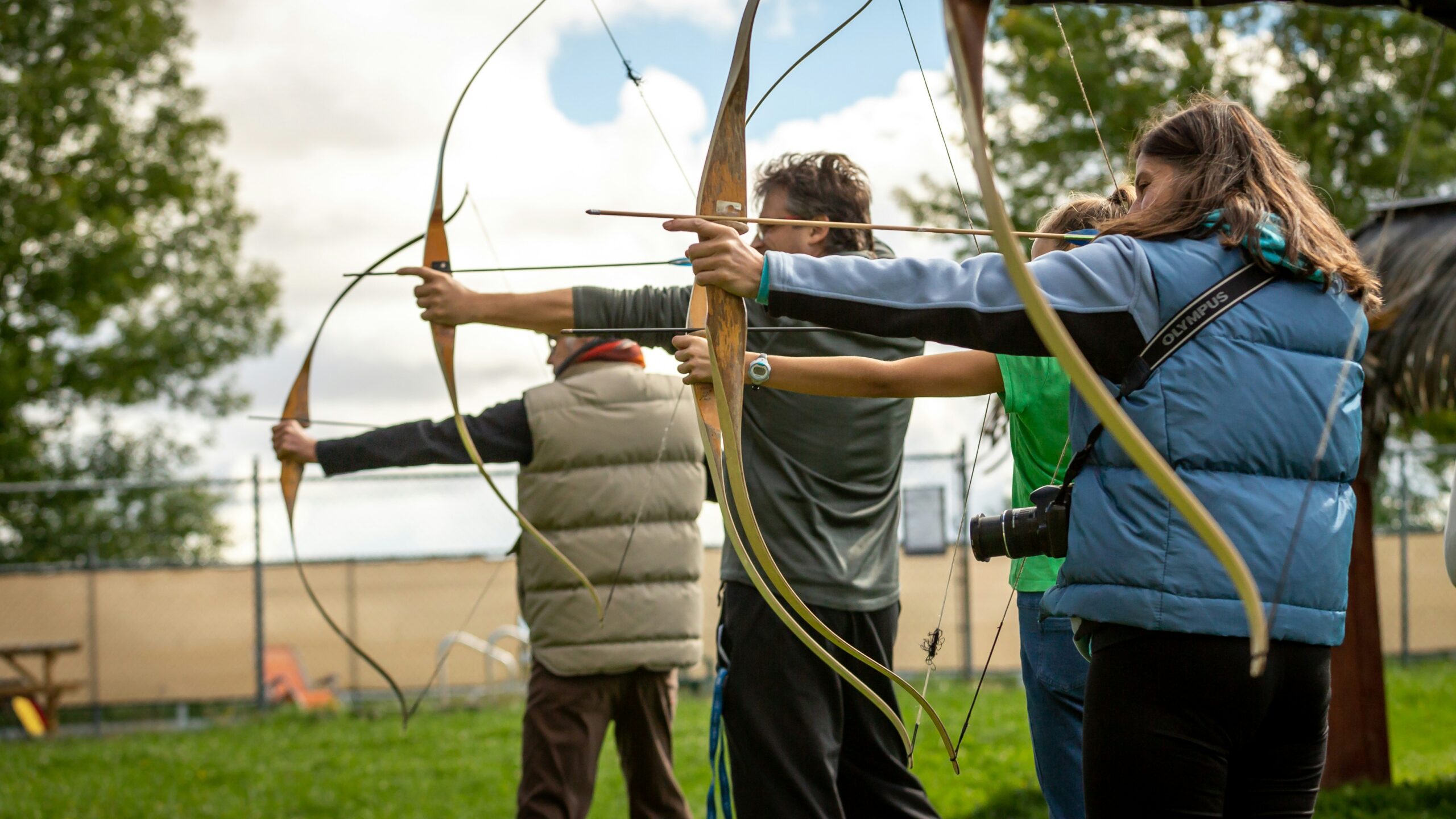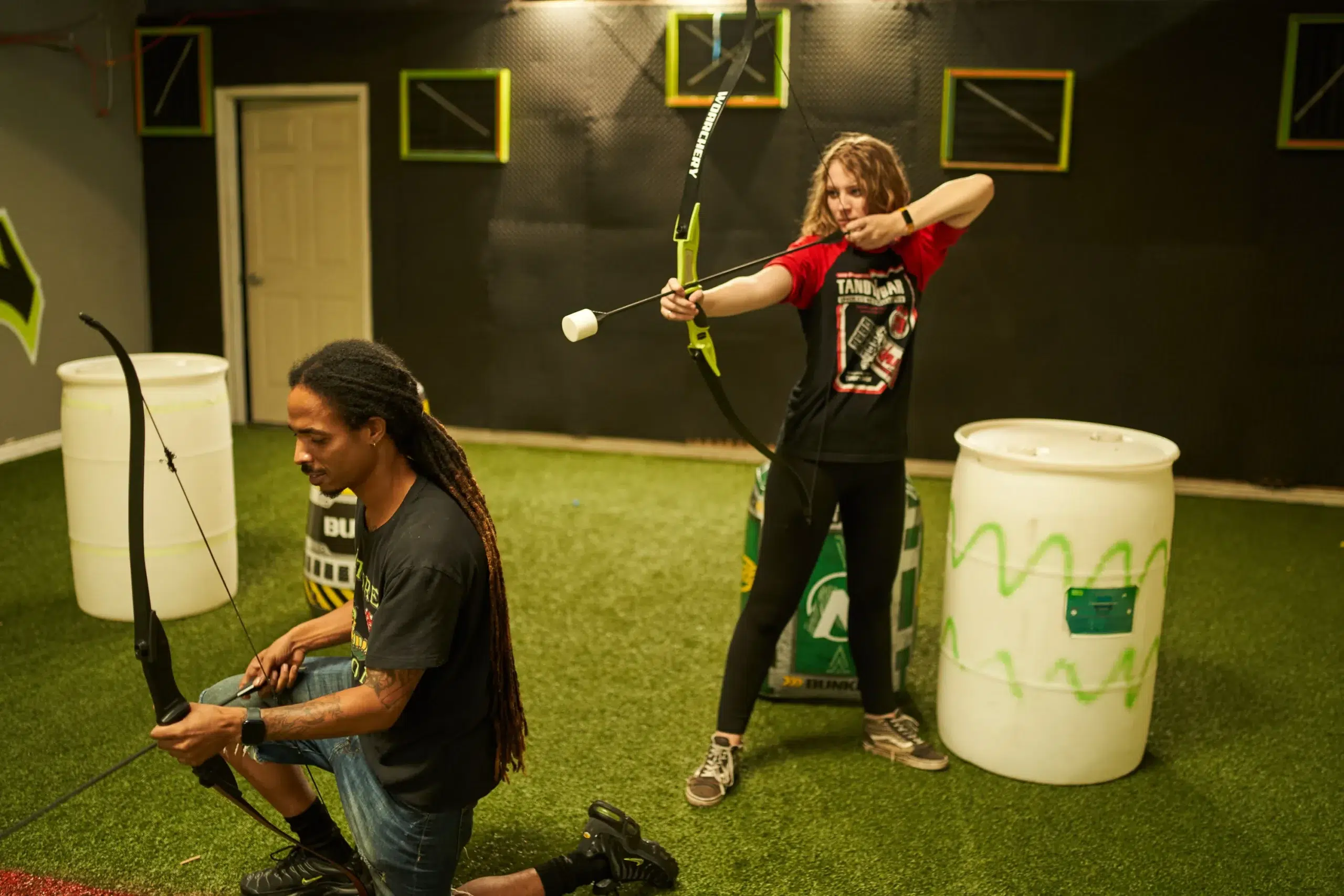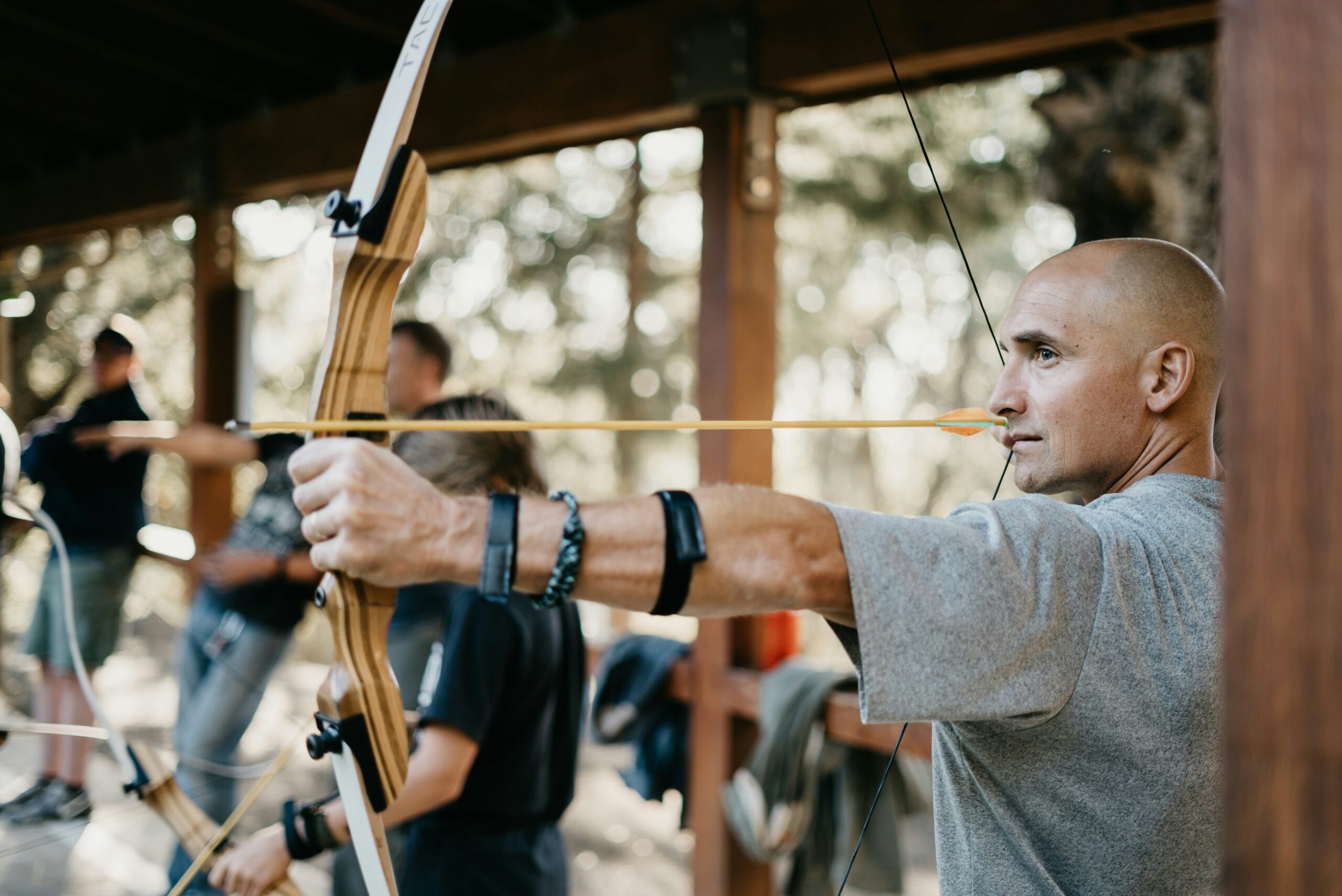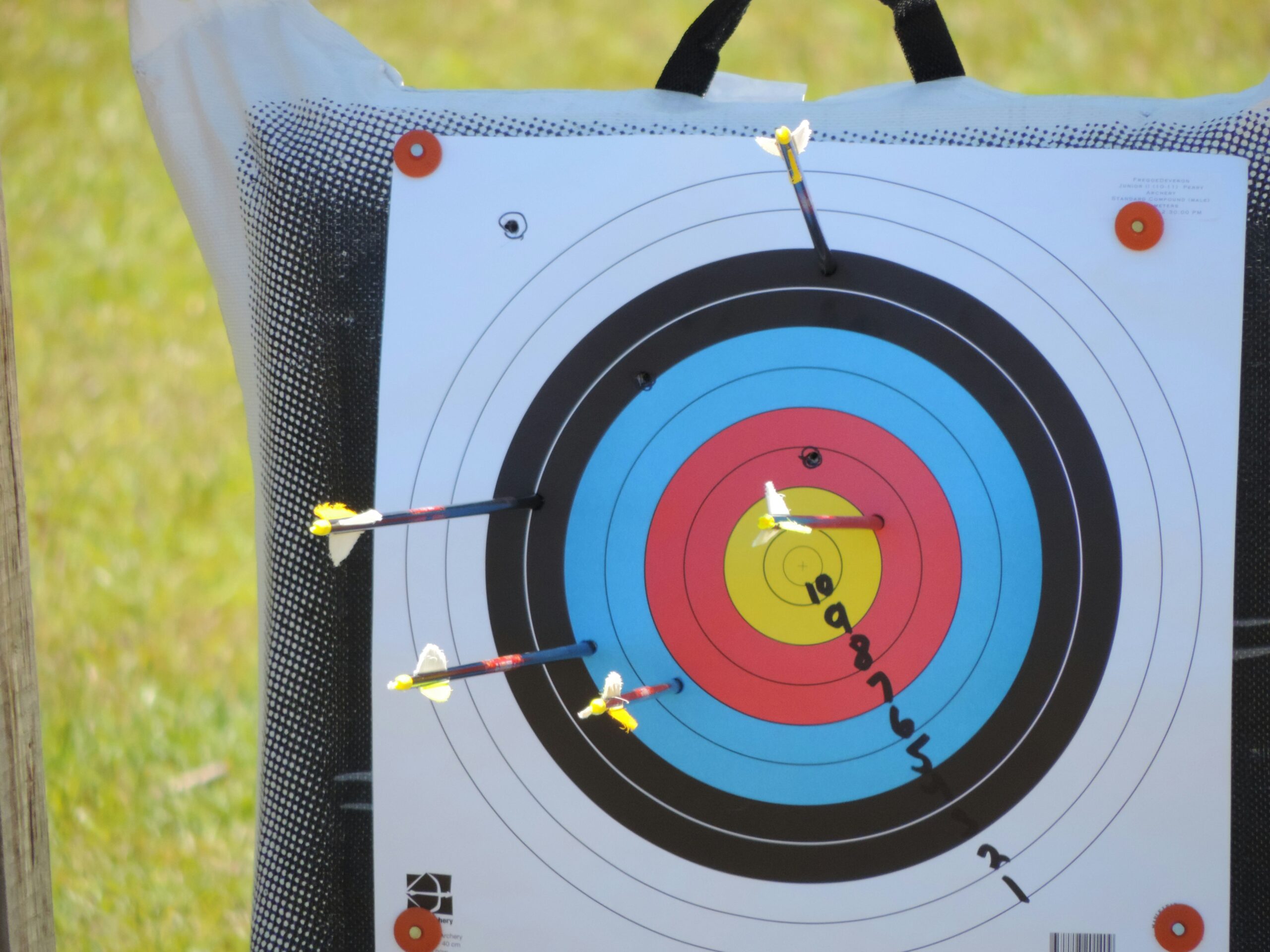Are you concerned about safety while playing Archery Tag? Many participants overlook protective measures, increasing the risk of injury. This blog post covers essential protective gear, setting up a safe playing field, and enforcing strict rules during gameplay. By following these guidelines, players can enjoy a fun and secure experience. Addressing safety in Archery Tag minimizes risks and ensures everyone can participate confidently, making your event more enjoyable and successful. Let’s explore how to make your Archery Tag experience safe for all participants.
Key Takeaways
- Properly fitting safety gear enhances comfort and protection during archery tag
- Conduct pre-game inspections to ensure all equipment is in good condition
- Designate safe zones for rest and strategy discussions to improve player safety
- Trained referees help maintain safety and enforce rules during gameplay
- Emergency preparedness measures, including first aid supplies, are essential for player safety
Mandatory Protective Gear for Archery Tag Participants

Selecting approved face masks is crucial for full eye and face protection during archery tag. Arm guards are key in preventing bruises, ensuring participants stay safe and comfortable. It’s essential to check the proper fit of all gear before play and conduct pre-game inspections. Lastly, recommended attire aids optimal movement and safety, allowing for an enjoyable experience in this striking combat archery sport.
Selecting Approved Face Masks for Full Eye and Face Protection
Selecting approved face masks is necessary for both eye and face protection during archery tag. These masks should meet safety standards to ensure participants remain shielded while enjoying the game. They must fit well to provide comfort and visibility, allowing players to focus on their strategy without distraction:
- Choose masks that cover the entire face while offering adequate venting.
- Ensure the mask fits snugly, preventing movement during play.
- Check for clear visibility to enhance game performance.
The Function of Arm Guards in Preventing Bruises
Arm guards are essential protective gear for archery tag participants, effectively preventing bruises and injuries caused by arrows during the game. These guards fit snugly on the forearms, acting as a buffer against impacts while allowing players to maintain mobility and flexibility. By providing this layer of protection, arm guards enable players to enjoy the excitement of archery tag without worrying about discomfort or pain that could detract from their overall experience.
Ensuring Proper Fit of All Safety Equipment Before Play
Ensuring the proper fit of all safety equipment before play is vital for a safe and enjoyable experience in archery tag. Participants should take the time to adjust face masks, arm guards, and other gear to avoid discomfort and distractions during gameplay. Properly fitted equipment enhances safety by providing the necessary protection against impacts and allows players to move freely, contributing to overall performance and enjoyment of the sport.
Pre-Game Inspection Routines for Protective Gear
Pre-game inspection routines for protective gear are essential to ensure safety during archery tag. These inspections allow participants to verify that their face masks, arm guards, and other equipment are in good condition and properly fitted. A few minutes before gameplay to check for damage or wear can prevent potential injuries and enhance overall enjoyment, allowing players to focus on their strategy without distraction.
Recommended Attire for Optimal Movement and Safety
Choosing the right attire is crucial for optimal movement and safety during archery tag. Players should wear comfortable clothing that allows for flexibility, such as athletic wear or layered outfits that won’t restrict movement. Footwear should provide good grip and support, ensuring stability during gameplay:
- Dress in breathable fabrics to stay cool during action.
- Select fitted clothing that won’t snag or interfere with gear.
- Opt for shoes with rubber soles for better traction on various surfaces.
Setting Up a Safe Archery Tag Playing Field

Establishing a safe environment for archery tag is essential for an enjoyable experience. Defining clear boundaries for the active game area helps maintain focus. Well-marked neutral zones and secure spectator viewing locations enhance safety. The proper placement of bunkers or obstacles adds excitement while minimizing risks. Conducting a field hazard assessment before games ensures thorough safety measures are in place, preparing everyone for a fun activity.
Defining Clear Boundaries for the Active Game Area
Defining clear boundaries for the active game area is essential in maintaining safety during archery tag. Marking these boundaries with visible signs or cones helps participants understand where they can play and where they need to stay clear. This clear designation prevents accidental collisions and reinforces the need for awareness of surroundings, allowing everyone to enjoy the game with confidence and energy.
Establishing Well-Marked Neutral or Safe Zones
Establishing well-marked neutral or safe zones is critical for maintaining safety during archery tag games. These zones serve as areas where players can regroup and strategize without the risk of being hit by arrows. By using clear markings like cones or tape, participants can easily identify these safe spaces, promoting awareness and ensuring everyone enjoys the game without unnecessary fear or distraction:
- Designate safe zones away from active gameplay areas.
- Mark these areas clearly to avoid confusion during matches.
- Encourage players to utilize these zones for strategy discussions and rest breaks.
Designating Secure Spectator Viewing Locations
Designating secure spectator viewing locations is vital for maintaining safety during archery tag games. These areas should be positioned safely from the active play zones, so spectators can enjoy the action without risk. By clearly marking these locations and ensuring that participants and spectators understand where to stand, the likelihood of accidents decreases, allowing everyone to focus on the excitement of the game without concern for safety.
Safe Placement and Use of Bunkers or Obstacles
Safe placement and use of bunkers or obstacles are vital components in creating an enjoyable and secure archery tag environment. Properly positioned barriers can increase excitement while also providing players with necessary cover from incoming arrows. It is essential to ensure these structures are stable and not easily movable, which enhances safety by preventing accidental collisions and allowing participants to remain focused on the game.
Conducting a Field Hazard Assessment Before Games Begin
Conducting a field hazard assessment before games begin is crucial for ensuring safety in archery tag. Participants should review the playing area for potential hazards such as uneven ground, obstacles, or any debris that could lead to tripping or injury. By addressing these issues beforehand, organizers create a safer environment, allowing everyone to focus on the game’s fun without worrying about unexpected dangers.
Enforcing Strict Rules for Safe Archery Tag Engagement

Prohibiting aiming at the head or neck area helps ensure participant safety during archery tag. Maintaining minimum shooting distances between players minimizes the risk of injury. Proper guidelines for handling bows and arrows during active play allow for smooth gameplay. Promoting sportsmanship and fair conduct enhances the experience, while consequences for breaching safety measures reinforce the importance of these rules. Each of these points contributes to a secure and enjoyable environment.
Prohibiting Aiming at the Head or Neck Area
Prohibiting aiming at the head or neck area is a fundamental safety rule in archery tag. This measure helps prevent serious injuries and ensures all participants have a safe and enjoyable experience. Keeping the focus on lower body targets encourages strategic gameplay while maintaining safety for everyone involved:
- Establish clear guidelines that prohibit head and neck shots.
- Provide training sessions to educate players about safe aiming practices.
- Implement penalties for players who violate these safety rules.
Maintaining Minimum Shooting Distances Between Players
Maintaining minimum shooting distances between players is a critical safety measure in archery tag that helps reduce the risk of injuries. Setting these distances allows participants to shoot arrows without worrying about close-range impacts, creating a safer environment for all. For instance, when players stand at least 10 to 15 feet apart during active play, it encourages strategic aiming while prioritizing safety, ensuring everyone can enjoy the excitement without unnecessary fear of accidents.
Guidelines for Handling Bows and Arrows During Active Play
Proper handling of bows and arrows during active play is essential for safety in archery tag. Participants should always keep their bows pointed down when not shooting, preventing accidental injuries. Additionally, players must wait for a clear signal from referees before taking shots, ensuring everyone is aware and prepared, which enhances the overall safety and enjoyment of the game.
Promoting Sportsmanship and Fair Play Conduct
Promoting sportsmanship and fair play in archery tag is vital for creating a safe and enjoyable environment. Encouraging players to respect each other and follow the established rules fosters a positive atmosphere. By highlighting the importance of teamwork and communication, participants can strategize effectively while minimizing conflicts, leading to a more fun experience for everyone involved.
Consequences for Breaching Archery Tag Field Safety Measures
Consequences for breaching archery tag field safety measures play a crucial role in maintaining a secure environment for all participants. Players who fail to follow rules, such as aiming at prohibited areas or violating shooting distances, may face penalties like temporary removal from the game or a warning from referees. Establishing clear consequences ensures that everyone understands the importance of safety, encourages responsible behavior, and allows everyone to enjoy the excitement of archery tag without unnecessary risks.
Correct Equipment Handling and Upkeep Procedures

Proper methods for nocking and shooting foam-tipped arrows are foundational for safety in archery tag. Regular bow inspections and string maintenance practices ensure equipment stays in top condition. Checking arrow conditions before, during, and after use helps maintain reliability, while securely storing gear when not in use prevents damage. Additionally, immediately identifying and retiring damaged equipment is crucial for participant safety.
Proper Methods for Nocking and Shooting Foam-Tipped Arrows
Proper methods for nocking and shooting foam-tipped arrows are essential for maintaining safety and enhancing performance in archery tag. Participants should start by securely placing the arrow on the bowstring, ensuring the fletched end is positioned correctly. When drawing back, players should aim in a safe direction, only releasing the arrow when instructed, which minimizes the risks of unintended injuries while ensuring an enjoyable gameplay experience:
- Ensure the arrow is properly nocked on the bowstring for safe shooting.
- Always draw the bowstring back in a safe direction.
- Wait for a clear signal before releasing the arrow.
Regular Bow Inspection and String Maintenance Practices
Regular bow inspections and string maintenance are vital components of archery tag safety. Participants should routinely check the bow for any signs of wear, such as cracks or frayed strings, which could affect performance and safety during play. Lubricating the bowstring can also improve its lifespan, ensuring that players can confidently rely on their equipment throughout the game, leading to a more enjoyable experience.
Checking Arrow Condition Before, During, and After Use
Checking the condition of arrows before, during, and after use is key for maintaining safety in archery tag. Participants should inspect each arrow for any signs of damage, such as cracks or bent shafts, which could lead to unreliable performance or injuries. Regular checks ensure that all arrows remain in good condition, allowing players to focus on the game without worrying about unexpected failures during play.
Storing Archery Tag Equipment Securely When Not in Use
Storing archery tag equipment securely when not in use is essential for maintaining its integrity and ensuring participant safety. All gear should be kept in a designated area that is dry and protected from the elements, ideally in protective cases or bags. This practice helps prevent damage to bows, arrows, and protective gear, allowing players to enjoy a safe and reliable experience during gameplay.
- Store bows in padded cases to avoid damage.
- Keep arrows neatly organized to prevent bending or breaking.
- Ensure protective gear is cleaned and dry before storage.
- Regularly check the storage area for safety and accessibility.
Immediately Identifying and Retiring Damaged Gear
Immediately identifying and retiring damaged gear is crucial for ensuring safety in archery tag. Participants should consistently check equipment for signs of wear, such as frayed bowstrings or cracked arrows, and remove any unsafe items from play. Regular gear assessment promotes a safer environment and enhances the overall experience by preventing unexpected equipment failure during gameplay.
Conclusion
Prioritizing safety in archery tag is crucial for an enjoyable experience. Implementing protective gear, such as face masks and arm guards, along with effective field organization, ensures participant well-being. Establishing clear rules and maintaining active supervision further promote a secure environment. By emphasizing these essential measures, organizers create a fun and safe atmosphere where players can fully immerse themselves in the excitement of the game.

